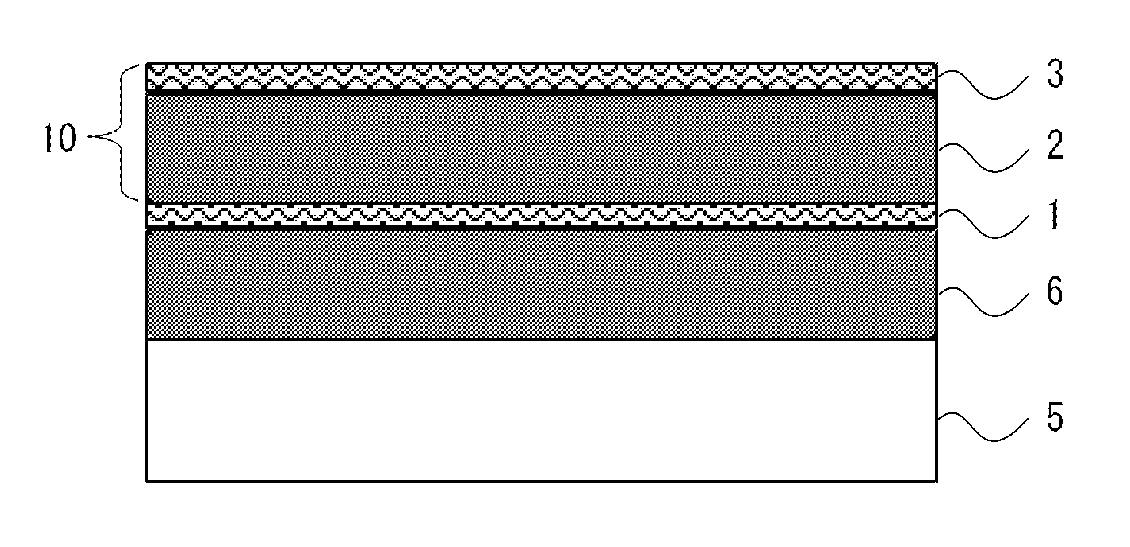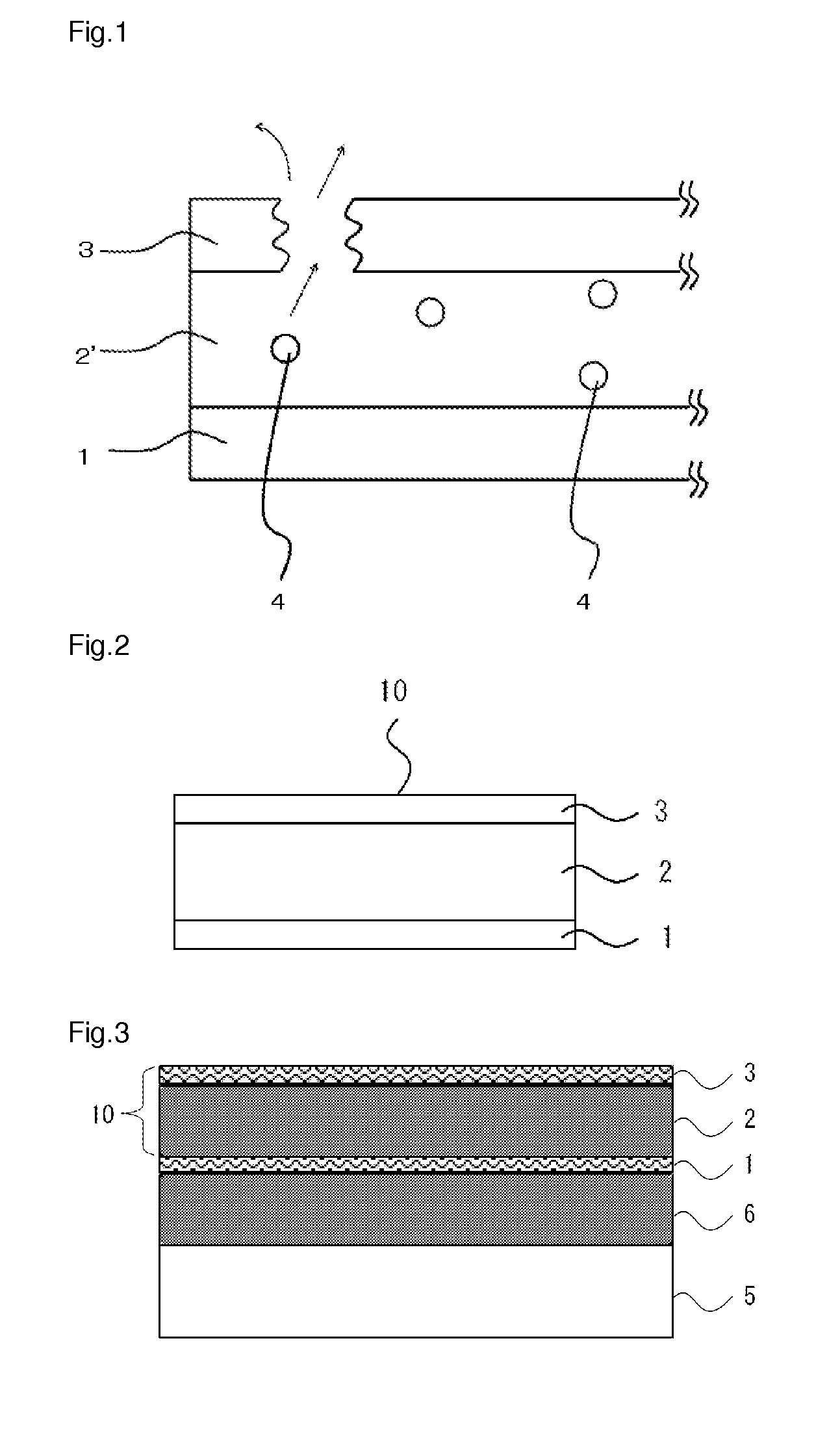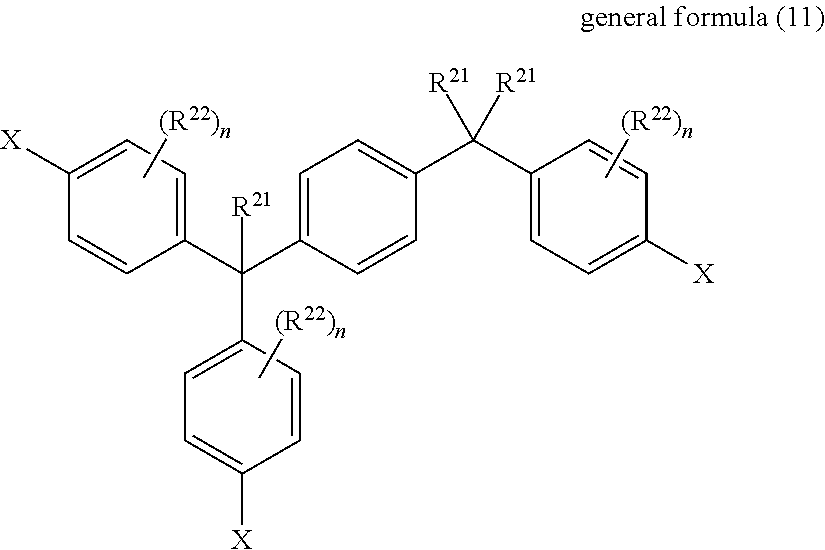Barrier laminate and novel polymer compound
a barrier film and polymer compound technology, applied in the field of barrier laminates and gas barrier films, can solve the problems of plastic film substrates that are heavier and tend to crack, plastic film substrates that are inferior to glass substrates, and have begun to be used instead of glass substrates. , to achieve the effect of enhancing heat resistance performance, reducing the amount of gas generation, and enhancing adhesion of organic layers
- Summary
- Abstract
- Description
- Claims
- Application Information
AI Technical Summary
Benefits of technology
Problems solved by technology
Method used
Image
Examples
reference example 1
[0121](Preparation of starting material epoxy compound) A 225.0 g quantity of 4,4′-(1,3-phenylenebis(2,2-propylidene))bisphenol was dissolved in epichlorohydrin (241.0 g) and the mixture was stirred for 6 hours at 60° C. In this process, a total of 4.4 g of 48% sodium hydroxide aqueous solution was added dropwise in two installments, once at the start of the reaction and once at two hours into the reaction. Subsequently, 48% sodium hydroxide aqueous solution (4.4 g) was added over two hours under reduced pressure. At the same time, water that had been added to the reaction system and water generated by the reaction system was removed.
[0122]When the reaction had ended, the excess epichlorohydrin was removed, toluene was added to the resinous product obtained, and the sodium chloride generated was removed by washing with water. Next, 10% sodium hydroxide aqueous solution (6.4 g) and benzyltriethyl ammonium chloride (0.4 mL) were added and the mixture was stirred for 90 minutes at 80° ...
synthesis example 1
Preparation of α,α′-bis[4-(3-acryloxy-2-hydroxypropoxy)phenyl]-α,α,α′,α′-tetramethyl-m-xylene
[0123]To a three-necked flask with a capacity of 300 mL equipped with stirring vanes, temperature gage, reflux condenser with calcium chloride tube on the front end, and capillaries for blowing in air were charged the bisphenol compound (epoxy equivalent 248) comprised chiefly of 4,4′-[1,3-phenylenebis(2,2-propylidene)]bis(phenyleneoxymethyleneoxirane) obtained in Reference Example 1 (37.2 g), acrylic acid (12.96 g), tetra-n-butylammonium bromide (2.42 g), hydroquinone monomethyl ether (0.025 g), 2,6-di-tert-butyl-4-methylphenol (0.025 g), and toluene (150 g). The mixture was then stirred while blowing in air, heated, and reacted for 8 hours under reflux to obtain EA-1-A.
[0124]When the reaction had ended, the acid value of the reaction mixture (solution) obtained was 8.0 mgKOH / g. The reaction mixture EA-1-A was cooled to room temperature, diluted by adding ethyl acetate (250 mL), and washed ...
reference example 2
Preparation of Starting Material Epoxy Compound
[0126]A 294.5 g quantity of 4,4′-(1-methylethylidene)bis(2-cyclohexylphenol) was dissolved in epichlorohydrin (695.0 g). Water (1.3 g) was then added and the mixture was stirred for 5 hours at 60° C. In this process, a total of 12.4 g of 48% sodium hydroxide aqueous solution was added dropwise in two installments, once at the start of the reaction and once at two hours into the reaction. Subsequently, 48% sodium hydroxide aqueous solution (130.0) was added over two hours under reduced pressure. At the same time, water that had been added to the reaction system and water generated by the reaction system was removed.
[0127]When the reaction had ended, the excess epichlorohydrin was removed. Methyl isobutyl ketone was added to the resin layer obtained and the sodium chloride produced was removed by washing with water. Next, 10% sodium hydroxide aqueous solution (229.5 g) and benzyl triethyl ammonium chloride (0.5 mL) were added, the mixture...
PUM
| Property | Measurement | Unit |
|---|---|---|
| pressure | aaaaa | aaaaa |
| pressure | aaaaa | aaaaa |
| roughness | aaaaa | aaaaa |
Abstract
Description
Claims
Application Information
 Login to View More
Login to View More - R&D
- Intellectual Property
- Life Sciences
- Materials
- Tech Scout
- Unparalleled Data Quality
- Higher Quality Content
- 60% Fewer Hallucinations
Browse by: Latest US Patents, China's latest patents, Technical Efficacy Thesaurus, Application Domain, Technology Topic, Popular Technical Reports.
© 2025 PatSnap. All rights reserved.Legal|Privacy policy|Modern Slavery Act Transparency Statement|Sitemap|About US| Contact US: help@patsnap.com



